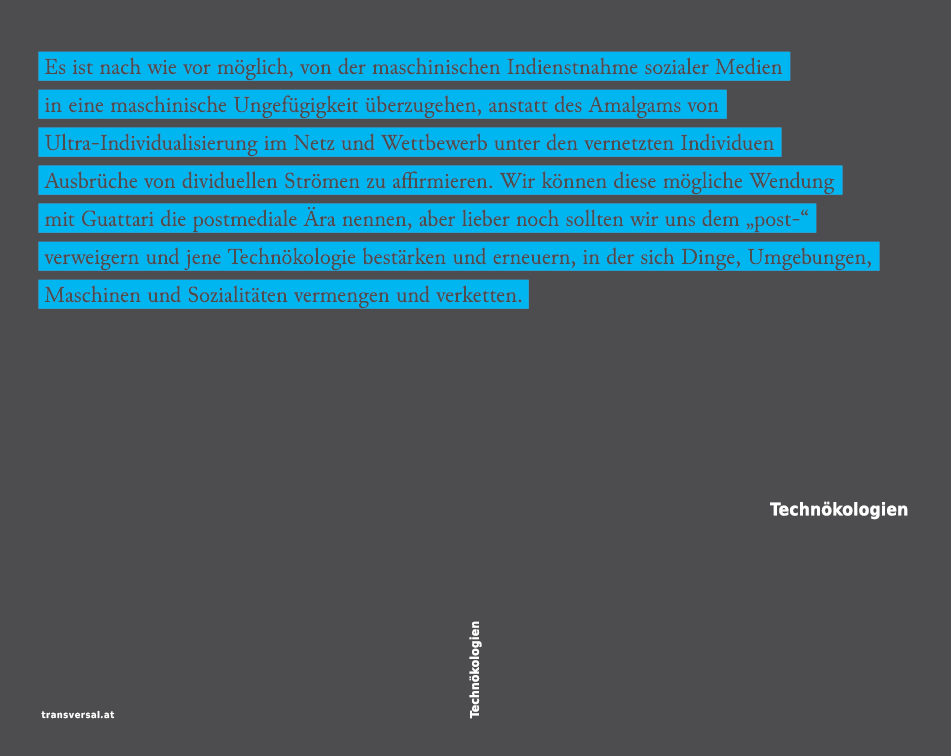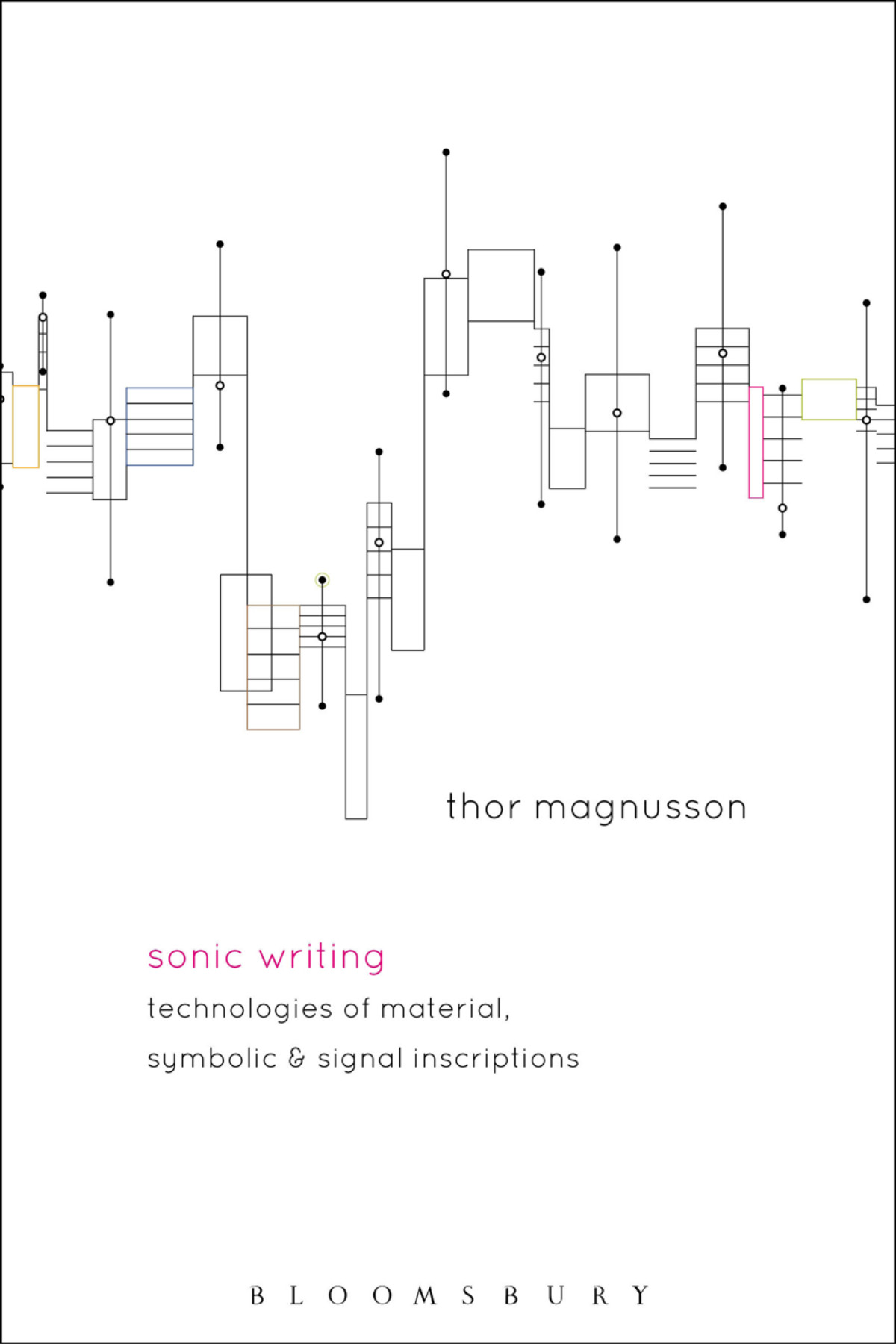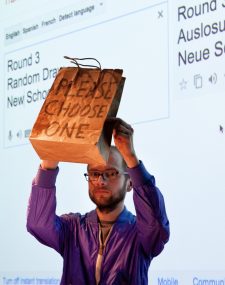Christoph Brunner, Raimund Minichbauer, Kelly Mulvaney, Gerald Raunig (eds.): Technökologien (2018) [German]
Filed under book | Tags: · ecology, environment, media, media archeology, social movements, technology, technopolitics

“Im dividuell-maschinischen Kapitalismus geht Technologie weit über die dichotomen Figuren von Techno-Euphorie (maschinischer Fortschritt in der Hand von Menschen) und Techno-Phobie (Menschen als Instrumente der Maschinen) hinaus. In so unterschiedlichen Feldern wie finanziellen Derivaten und Kryptowährungen, digitalen Schnitten und Data Doubles, biometrischen Filmbildern und sozialen Medien werden Technologien zu Umwelt, Umhüllung, Umgebung.
Mit dem Begriffsvorschlag Technökologien und Beispielen aus der Medienarchäologie der 1990er und 2000er Jahre, vor allem aber anhand der Untersuchung konkreter aktueller Praxen versucht das vorliegende Buch, diesen Verschiebungen gerecht zu werden: In der Mitte der technökologischen Subjektivierung, die nicht selten die Form von Wut, Angst, Hass und Häme annimmt, ergeben sich auch neue Weisen der Affizierung, neue Äußerungsweisen, neue Verhältnissetzungen von Technopolitik und sozialer Bewegung.
Mit Beiträgen von: Christoph Brunner, Marco Deseriis, Katrin M. Kämpf und Christina Rogers, Brigitta Kuster, Stamatia Portanova, Gerald Raunig, Álvaro Ruiz, Raúl Sánchez Cedillo.”
Publisher transversal texts, Vienna, August 2018
Copyleft
ISBN 9783903046214, 3903046213
157 pages
Thor Magnusson: Sonic Writing: Technologies of Material, Symbolic, and Signal Inscriptions (2019)
Filed under book | Tags: · artificial intelligence, computer music, machine learning, media, media technology, media theory, music, musical instruments, notation, phonograph, sound, sound recording, writing

“Sonic Writing explores how contemporary music technologies trace their ancestry to previous forms of instruments and media. Studying the domains of instrument design, musical notation, and sound recording under the rubrics of material, symbolic, and signal inscriptions of sound, the book describes how these historical techniques of sonic writing are implemented in new digital music technologies. With a scope ranging from ancient Greek music theory, medieval notation, early modern scientific instrumentation to contemporary multimedia and artificial intelligence, it provides a theoretical grounding for further study and development of technologies of musical expression. The book draws a bespoke affinity and similarity between current musical practices and those from before the advent of notation and recording, stressing the importance of instrument design in the study of new music and projecting how new computational technologies, including machine learning, will transform our musical practices.
Sonic Writing offers a richly illustrated study of contemporary musical media, where interactivity, artificial intelligence, and networked devices disclose new possibilities for musical expression. Thor Magnusson provides a conceptual framework for the creation and analysis of this new musical work, arguing that contemporary sonic writing becomes a new form of material and symbolic design–one that is bound to be ephemeral, a system of fluid objects where technologies are continually redesigned in a fast cycle of innovation.”
Publisher Bloomsbury Academic, New York & London, 2019
ISBN 9781501313851, 1501313851
xiv+290 pages
Reviews: Gregory Taylor (Cycling ’74, 2019), Diana Chester (Interference, 2019).
Author’s research blog
Publisher
WorldCat
Amodern, 8: Translation-Machination (2018)
Filed under journal | Tags: · language, machine, machine learning, media, technique, translation

“Amodern 8 explores the contexts and implications of translation as mechanism, media, technique, and transmission. Our tethering of “translation” to “machination” marks our intention to move beyond the habit of situating MT and computer-generated language in the familiar crisis poses of fakery, treason, and inauthenticity. Rather than regarding the machine as marking the limits of translation – an assumption that risks walling off translation practice from media and communication studies concerns, while still absorbing its products – our aim is to continue to investigate the possibilities and configurations of translation as machined, and translation as machining meaning, historically and in the contemporary moment.”
With contributions by Rita Raley, Otso Huopaniemi, John Cayley, Christine Mitchell, Tiffany Chan, Mara Mills, Jentery Sayers, Avery Slater, Quinn DuPont, Andrew Pilsch, Nick Montfort, Jane Birkin, Karin Littau, and Joe Milutis.
Edited by Christine Mitchell and Rita Raley
Publisher Concordia University and Lakehead University, January 2018
Creative Commons Attribution-Non Commercial 3.0 Unported License

